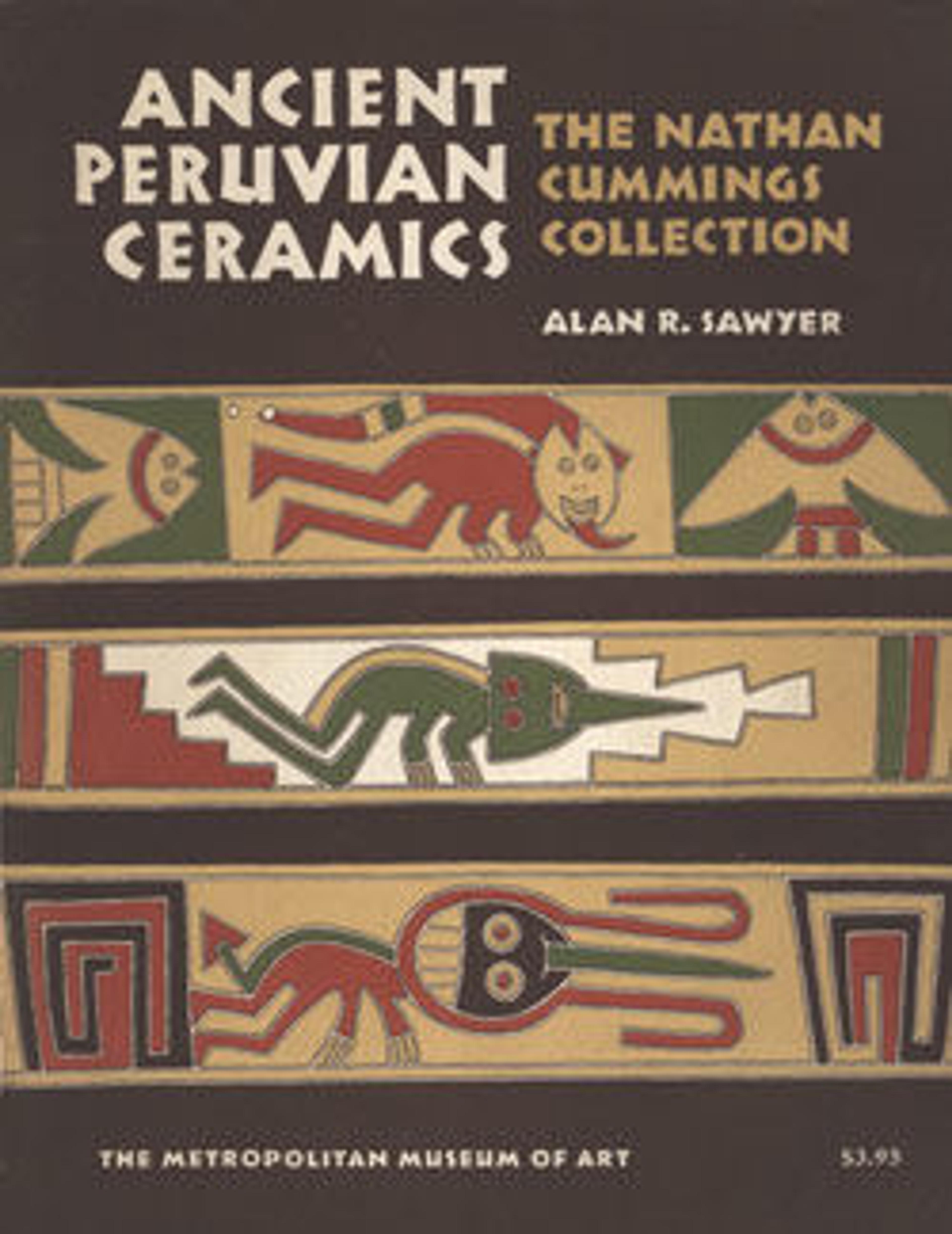Double-chambered bottle with mouse
Recuay communities (200-700 CE) of highland Ancash (Peru) are known for their elaborate sculptures in clay, comparable to their coastal neighbors, the Moche and the Nasca. Many are functionally vessels, such as this example that joins two chambers, one surmounted by a rodent nibbling on food. A small bridge was placed on top to function as a handle.
Created using iron-poor clays such as kaolinite, the vessel’s body takes on a light tan color after firing. The richly decorated surface was created with a complex combination of slips and resist-painting. The first step consisted in applying white clay to cover large areas of the object, as if creating a canvas where complex figures will be painted. Then, iron-rich red ochre was applied to delineate the panels on the body of the chambers as well as the details of the rodent. Finally, in a second firing, additional details were added using a resist-painting technique.
The body of the rodent features patterning that resembles the fur of animals such as tapirs and deer in their juvenile stage. While the shape of the present creature suggests a rodent, the pattern of the fur must have been used as an indicator of its age. The panels differ in subject matter: on the chamber with the rodent, the artist painted mirrored versions of an animal with toothy snout and rampant pose, sometimes referred as the “Recuay dragon” or “crested feline” (Lau, 2011: 207-208). On the other chamber, the artist painted a pair of birds.
Hugo C. Ikehara-Tsukayama, Senior Research Associate, Arts of the Ancient Americas, 2023
References and Further Reading
Ibarra Asencios, Bebel (ed.). Arqueología de la sierra de Ancash: Propuestas y perspectivas. Second edition. Lima: Instituto Cultural Rvna, 2004.
Lau, George F. “Feasting and Ancestor Veneration at Chinchawas, North Highlands of Ancash, Peru.” Latin American Antiquity Vol. 13, No. 3 (2002): 279-304.
Lau, George F. Ancient Alterity in the Andes: A Recognition of Others. London: Routledge, 2013.
Lau, George F. An Archaeology of Ancash: Stone, Ruins, and Communities in Andean Peru. London: Routledge, 2016.
Ponte, Victor. “Transformación social y política en el Callejón de Huaylas, siglos III-X d.C.” Boletín de Arqueología PUCP No. 4 (2001): 219-51.
Lau, George F. Andean Expressions: Art and Archaeology of the Recuay Culture. Iowa City: University of Iowa Press, 2011.
Created using iron-poor clays such as kaolinite, the vessel’s body takes on a light tan color after firing. The richly decorated surface was created with a complex combination of slips and resist-painting. The first step consisted in applying white clay to cover large areas of the object, as if creating a canvas where complex figures will be painted. Then, iron-rich red ochre was applied to delineate the panels on the body of the chambers as well as the details of the rodent. Finally, in a second firing, additional details were added using a resist-painting technique.
The body of the rodent features patterning that resembles the fur of animals such as tapirs and deer in their juvenile stage. While the shape of the present creature suggests a rodent, the pattern of the fur must have been used as an indicator of its age. The panels differ in subject matter: on the chamber with the rodent, the artist painted mirrored versions of an animal with toothy snout and rampant pose, sometimes referred as the “Recuay dragon” or “crested feline” (Lau, 2011: 207-208). On the other chamber, the artist painted a pair of birds.
Hugo C. Ikehara-Tsukayama, Senior Research Associate, Arts of the Ancient Americas, 2023
References and Further Reading
Ibarra Asencios, Bebel (ed.). Arqueología de la sierra de Ancash: Propuestas y perspectivas. Second edition. Lima: Instituto Cultural Rvna, 2004.
Lau, George F. “Feasting and Ancestor Veneration at Chinchawas, North Highlands of Ancash, Peru.” Latin American Antiquity Vol. 13, No. 3 (2002): 279-304.
Lau, George F. Ancient Alterity in the Andes: A Recognition of Others. London: Routledge, 2013.
Lau, George F. An Archaeology of Ancash: Stone, Ruins, and Communities in Andean Peru. London: Routledge, 2016.
Ponte, Victor. “Transformación social y política en el Callejón de Huaylas, siglos III-X d.C.” Boletín de Arqueología PUCP No. 4 (2001): 219-51.
Lau, George F. Andean Expressions: Art and Archaeology of the Recuay Culture. Iowa City: University of Iowa Press, 2011.
Artwork Details
- Title: Double-chambered bottle with mouse
- Artist: Recuay artist(s)
- Date: 200–700 CE
- Geography: Peru, Ancash
- Culture: Recuay
- Medium: Ceramic, slip
- Dimensions: H. 6 × W. 5 × D. 5 in. (15.2 × 12.7 × 12.7 cm)
- Classification: Ceramics-Containers
- Credit Line: Gift of Nathan Cummings, 1966
- Object Number: 66.30.2
- Curatorial Department: The Michael C. Rockefeller Wing
More Artwork
Research Resources
The Met provides unparalleled resources for research and welcomes an international community of students and scholars. The Met's Open Access API is where creators and researchers can connect to the The Met collection. Open Access data and public domain images are available for unrestricted commercial and noncommercial use without permission or fee.
To request images under copyright and other restrictions, please use this Image Request form.
Feedback
We continue to research and examine historical and cultural context for objects in The Met collection. If you have comments or questions about this object record, please complete and submit this form. The Museum looks forward to receiving your comments.
